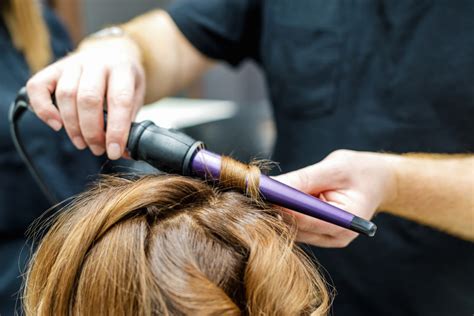As a hair enthusiast, achieving the perfect curls is an art form that requires the right tools. But with the plethora of curling iron materials available, choosing the best one can be a daunting task. To simplify your search, we’ve compiled a comprehensive guide to 21 superior materials, empowering you to make an informed decision that aligns with your hair needs and styling preferences.

1. Titanium: The Heat Conductor Extraordinaire
Titanium is a lightweight, durable metal that distributes heat evenly, allowing for consistent curls from root to tip. It heats up quickly, reducing styling time and minimizing hair damage.
-
Pros:
- Excellent heat conductor
- Long-lasting durability
- Minimizes hair damage
-
Cons:
- Can be expensive
2. Ceramic: The Gentle Giant for Delicate Strands
Ceramic is a non-porous material that emits negative ions, which help seal hair cuticles, reduce frizz, and enhance shine. Its gentle heat distribution protects hair from overheating and breakage.
-
Pros:
- Emits negative ions for frizz control
- Protects hair from damage
- Affordable option
-
Cons:
- May not heat up as quickly as other materials
3. Tourmaline: The Ion-Enhancing Marvel
Tourmaline is a semi-precious gemstone that naturally emits abundant negative ions. These ions counteract positive ions in the hair, resulting in reduced frizz, increased shine, and healthier-looking curls.
-
Pros:
- Exceptional negative ion emission
- Improves hair health and shine
- Relatively affordable
-
Cons:
- Can be less durable than other materials
4. Ionic: The Anti-Frizz Champion
Ionic curling irons release negative ions that help break down water molecules into smaller clusters, which reduces frizz and promotes smoother, more defined curls.
-
Pros:
- Effectively reduces frizz
- Enhances curl definition
- Suitable for all hair types
-
Cons:
- May not provide optimal temperature control
5. Teflon: The Non-Stick Savior
Teflon is a non-stick coating that prevents hair from sticking to the barrel, ensuring effortless styling and minimizing hair breakage.
-
Pros:
- Non-stick surface for tangle-free curls
- Smooths hair texture
- Easy to clean
-
Cons:
- Can deteriorate over time
- May release harmful fumes when heated
6. Gold: The Luxurious and Antibacterial Option
Gold is a luxurious material that distributes heat evenly and is naturally antibacterial. It creates shiny, frizz-free curls while protecting hair from damage.
-
Pros:
- Excellent heat conductor
- Antibacterial properties
- Creates soft, lustrous curls
-
Cons:
- Expensive investment
- May be less durable than other materials
7. Silver: The Antibacterial and Antimicrobial Superhero
Silver is an antimicrobial and antibacterial metal that helps prevent scalp infections and other hair-related issues. It creates sleek, voluminous curls while promoting hair health.
-
Pros:
- Antibacterial and antimicrobial properties
- Promotes hair health
- Creates voluminous, shiny curls
-
Cons:
- Can be expensive
- May tarnish over time
8. Platinum: The Durable and Corrosion-Resistant King
Platinum is a durable, corrosion-resistant metal that provides exceptional heat conduction and longevity. It creates long-lasting, frizz-free curls with minimal hair damage.
-
Pros:
- Durable and corrosion-resistant
- Excellent heat conductor
- Creates long-lasting, healthy curls
-
Cons:
- Expensive option
- May not heat up as quickly as other materials
9. Nano-Titanium: The Ultra-Lightweight Conductor
Nano-titanium is an ultra-lightweight material that combines the benefits of titanium with advanced technology. It heats up rapidly, creating sleek, shiny curls without weighing hair down.
-
Pros:
- Ultra-lightweight and durable
- Fast heat-up time
- Creates voluminous, frizz-free curls
-
Cons:
- Can be more expensive than traditional titanium
10. Nano-Ceramic: The Gentle and Protective Conduit
Nano-ceramic is a fusion of ceramic and advanced technology. It emits negative ions, protects hair from damage, and distributes heat evenly for consistent, long-lasting curls.
-
Pros:
- Combines the benefits of ceramic and nanotechnology
- Protects hair from damage
- Creates smooth, healthy curls
-
Cons:
- May be slightly more expensive than traditional ceramic
11. Nano-Ionic: The Negative Ion Powerhouse
Nano-ionic curling irons harness the power of negative ions and advanced technology. They emit an abundance of negative ions, resulting in reduced frizz, increased shine, and enhanced hair health.
-
Pros:
- Exceptional negative ion emission
- Promotes hair health and shine
- Creates defined, frizz-free curls
-
Cons:
- May be more expensive than traditional ionic models
12. Carbon Fiber: The Lightweight and Durable Contender
Carbon fiber is a lightweight, durable material that is often used in high-performance racing cars. It provides excellent heat conduction and resists corrosion, making it a durable choice for curling irons.
-
Pros:
- Lightweight and durable
- Excellent heat conductor
- Corrosion-resistant
-
Cons:
- May be more expensive than other materials
- Can be less flexible than other materials
13. Graphite: The Heat-Resistant and Corrosion-Proof Champion
Graphite is a heat-resistant and corrosion-proof material that is commonly used in brake pads and electrodes. It provides exceptional heat conduction and is less likely to cause hair damage than other materials.
-
Pros:
- Heat-resistant and corrosion-proof
- Excellent heat conductor
- Less likely to damage hair
-
Cons:
- May be more expensive than other materials
- Can be less durable than other materials
14. Tourmaline-Ceramic: The Frizz-Fighting Fusion
Tourmaline-ceramic curling irons combine the benefits of tourmaline and ceramic materials. They emit negative ions, protect hair from damage, and distribute heat evenly for frizz-free, healthy curls.
-
Pros:
- Combines the benefits of tourmaline and ceramic
- Reduces frizz and enhances shine
- Creates smooth, voluminous curls
-
Cons:
- May be more expensive than traditional tourmaline or ceramic models
